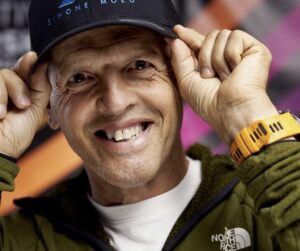Everybody is suffering from the long wait in K2 Base Camp, but no one has spent as much time there as John Snorri, Muhammad Ali Sadpara, and Sajid Sadpara. They were first to reach it, on December 5, and have worked on the mountain since then whenever the weather permitted.
Last week, they launched their first summit bid, although they were aware of the narrow weather window. They ultimately failed when a blizzard rolled in prematurely. Escaping unharmed from a storm at 6,800m on K2 in winter is anything but easy, especially without supplementary O2.
In an exclusive interview from Base Camp, John Snorri told ExplorersWeb that while the summit has evaded them for now, they showed that it is not impossible for a fully no-O2 team to attempt the summit of K2 in winter.

John Snorri in Base Camp, two long months ago. Photo: John Snorri
Snorri does not regret the team’s decision to go for it last week. “We felt strong and fully prepared, and we made it from Base Camp to Camp 3* in one go, which is great,” he said. “I am just disappointed that the weather didn’t hold. The wind hit us suddenly at 6,500m, straight in our faces.”
“The wind was too strong at 6,800m,” he went on. “We had a hard time trying to pitch the tent and one backpack was picked up from the ground and blew away.” They waited in vain for the wind to drop, then chose to return to Base Camp.
[*Note: Snorri states that the team reached Camp 3, although Snorri’s tracker indicated that they stopped at 6,817m, and Camp 3 is usually a little higher, between 7,000 and 7,400m, above the Black Pyramid. ExWeb has asked Snorri for more details.]
They lost that battle, but they haven’t given up. “Of course we will push again, hopefully on February 1 or 2. If the wind drops, we could reach the top by February 3 or 4.”
As for the use of supplementary O2, K2 itself might have decided for them how they must proceed. The backpack that blew away held all their oxygen masks and regulators.
“We found some of the stuff 2,000m below, at Advanced Base Camp, but we could find only one mask and no regulators. We are still searching, but if we don’t find the gear, we will all go without oxygen. We are well-acclimatized, and I believe that we won’t have problems, but the main issue is that without oxygen, you go slower. Still, we took just 16 hours from Base Camp to Camp 3, which is a fast enough pace and proves that we really can summit without oxygen.”
If they go no-O2, theirs will be a significantly different attempt than the one led by the Nepalis. With everyone climbing in the same way, the ones with O2 would not be able to take the lead and help the others, if necessary. And while the route has previously been fixed, ropes, tents (even if folded), and caches may have been damaged after so many days of gale-force winds, or even buried beneath rock-hard snow or blown away.

The route is fixed on K2, but in what state? Snorri with an ice-crusted rope behind him at Camp 2 on January 15. Photo: John Snorri
Also, while the Nepalis climbed as a well-coordinated team, the next push up the mountain will likely include several groups, each at its own pace and with its own caches, some with bottled oxygen, some without. It remains to be seen whether the climbers currently in Base Camp will coordinate efforts, make alliances, or climb independently.
Snorri intends to keep working as a three-man, self-sufficient team, but that doesn’t mean they are not ready to help. “I put this team together as a joint Iceland-Pakistan effort,” he said. “However, we have a really good relationship with the other teams and we are ready to share, especially considering that we will all likely push for the summit together during the next window.”
Snorri believes that they might all have just this one last chance to summit. “Historically, weather patterns turn for the worse after February 10 to 15,” he says. “But we will continue until the end of the season if necessary.”

John Snorri, centre, with Muhammad Ali Sadpara, left, and Sajid Sadpara. Photo: John Snorri






